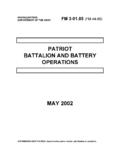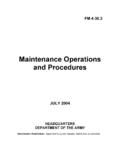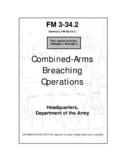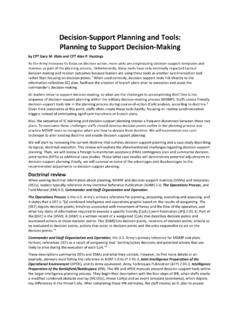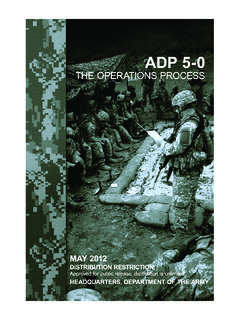Transcription of Field Manual (FM) 2-0: Intelligence - BITS
1 Intelligence fm 2 -0 HEADQUARTERS DEPARTMENT OF THE ARMY DISTRIBUTION RESTRICTION:Approved for public release, distribution is unlimitedMAY 2004* fm 2 -0 DISTRIBUTION RESTRICTION: Approved for public release; distribution is unlimited. _____ *This publication supersedes FM 34-1, 27 September 1994. i Field Manual Headquarters No. 2-0 Department of the Army Washington, DC, 17 May 2004 Intelligence Contents Page v PART ONE Intelligence IN THE OPERATIONAL ENVIRONMENT Chapter 1 Intelligence AND THE OPERATIONAL Role of The Intelligence Battlefield Operating Intelligence Tasks (METL)..1-3 The Operational Environment ..1-19 Dimensions of the Operational Critical Variables of the Contemporary Operational Environment ..1-23 The Intelligence Intelligence Force Projection Operations ..1-31 Chapter 2 Intelligence AND UNIFIED Unified Action.
2 2-1 The Levels of War ..2-1 Categories of Intelligence Unified Action Intelligence Operations ..2-12 Intelligence fm 2 -0_____ PART TWO Intelligence IN FULL SPECTRUM OPERATIONS Chapter 3 FUNDAMENTALS IN FULL SPECTRUM Full Spectrum Elements of Combat The Foundations of Army The Operational Army Chapter 4 Intelligence PROCESS IN FULL SPECTRUM The Intelligence Collect ..4-8 Common Intelligence Process PART THREE MILITARY Intelligence DISCIPLINES Chapter 5 ALL-SOURCE Fundamentals ..5-2 Chapter 6 HUMAN HUMINT Operational HUMINT Integration of Battle Chapter 7 IMAGERY Fundamentals ..7-1 ii _____FM 2-0 Chapter 8 SIGNALS Fundamentals ..8-1 Chapter 9 MEASUREMENT AND SIGNATURES Fundamentals ..9-4 Chapter 10 TECHNICAL Fundamentals ..10-1 Chapter 11 Counterintelligence Operational Counterintelligence Integration of Battle Appendix A Intelligence AND INFORMATION The Information The Commander and Information.
3 A-1 Information Appendix B LINGUIST Role of Linguistic Support Categories ..B-1 Determining Linguist Planning and Managing Linguist Support ..B-2 Sources of Evaluating Linguist Proficiency ..B-10 Sustaining Military Linguist iii fm 2 -0_____ iv Preface fm 2 -0 is the Army s keystone Manual for military Intelligence (MI) doctrine. It describes The fundamentals of Intelligence operations. The operational environment (OE). Intelligence in unified action. The Intelligence Battlefield Operating System (BOS). Intelligence considerations in strategic readiness.
4 The Intelligence process. MI roles and functions within the context of Army operations. This Manual conforms to the overarching doctrinal precepts presented in FM 3-0. This Manual provides doctrinal guidance for the Intelligence BOS actions in support of commanders and staffs. It also serves as a reference for personnel who are developing doctrine; tactics, techniques, and procedures (TTP); materiel and force structure; and institutional and unit training for Intelligence operations. This Manual provides MI guidance for all commanders, staffs, trainers, and MI personnel at all echelons. It forms the foundation for MI and the Intelligence BOS doctrine development, and applies equally to the Active Component (AC), United States Army Reserve (USAR), and Army National Guard (ARNG).
5 It is also intended for commanders and staffs of joint and combined commands, US Naval and Marine Forces, units of the US Air Force, and the military forces of multinational partners. Headquarters, US Army Training and Doctrine Command is the proponent for this publication. The preparing agency is the US Army Intelligence Center and School. Send written comments and recommendations on DA Form 2028 (Recom-mended Changes to Publications and Blank Forms) directly to: Commander, ATZS-FDT-D ( fm 2 -0), 550 Cibeque Street, Fort Huachuca, AZ 85613-7017. Send comments and recommendations by e-mail to Follow the DA Form 2028 format or submit an electronic DA Form 2028. Unless otherwise stated, masculine nouns and pronouns do not refer exclusively to men. This Manual contains Army tactical task (ART) description taken verbatim from the Army Universal Task List (AUTL).
6 ART task descriptions are followed by a reference to FM 7-15 in parentheses and the ART number; for example (See FM 7-15, ART ). v PART ONE Intelligence in the Operational Environment Part One discusses MI s role in peace, conflict, and war. Supporting the warfighter with effective Intelligence is the primary focus of Military Intelligence . Intelligence provides commanders and decisionmakers with the requisite information facilitating their situational understanding so that they may successfully accomplish their missions in full spectrum operations. Chapter 1 describes the operational environment and the roles of MI within the operational environment. It introduces the Intelligence BOS, the Intelligence tasks, and the Intelligence process, which are the mechanisms through which MI supports the warfighter.
7 This chapter also introduces the Intelligence disciplines, which are explained in detail in Part Three of this Manual . Chapter 2 describes the interaction of MI within the nation s Intelligence community structure, providing an overview of the Intelligence community at the national level and the unified action level joint, multinational, and interagency aspects of full spectrum operations. This chapter also discusses the concepts and components of Intelligence reach. Chapter 1 Intelligence and the Operational Environment ROLE OF Intelligence 1-1. The commander requires Intelligence about the enemy and the battlespace prior to engaging in operations in order to effectively execute battles, engagements, and other missions across the full spectrum of operations.
8 Intelligence assists the commander in visualizing his battlespace, organizing his forces, and controlling operations to achieve the desired tactical objectives or end-state. Intelligence supports force protection (FP) by alerting the commander to emerging threats and assisting in security operations. 1-2. The unit may need to deal with multiple threats. The commander must understand how current and potential enemies organize, equip, train, employ, and control their forces. Intelligence provides an understanding of the enemy, which assists in planning, preparing, and executing military operations. The commander must also understand his OE and its effects on both his own and enemy operations. The commander receives mission-oriented Intelligence on enemy forces and the area of operations (AO) from 1-1 fm 2 -0_____ the G2/S2.
9 The G2/S2 depends upon the Intelligence , surveillance, and reconnaissance (ISR) effort to collect and provide information on the enemy and battlespace. 1-3. One of the most significant contributions that Intelligence personnel can accomplish is to accurately predict future enemy events. Although this is an extremely difficult task, predictive Intelligence enables the commander and staff to anticipate key enemy events or reactions and develop corresponding plans or counteractions. The most important purpose of Intelligence is to influence decisionmaking. Commanders must receive the Intelligence , understand it (because it is tailored to the commander s requirements), believe it, and act on it. Through this doctrinal concept, Intelligence drives operations.
10 THE Intelligence BATTLEFIELD OPERATING SYSTEM 1-4. The Intelligence Battlefield Operating System (BOS) is one of seven battlefield operating systems Intelligence , maneuver, fire support (FS), air defense, mobility/countermobility/survivability, combat service support (CSS), and command and control (C2) that enable commanders to build, employ, direct, and sustain combat power. The Intelligence BOS is a flexible force of personnel, organizations, and equipment that, individually or collectively, provide commanders with the timely, relevant, and accurate Intelligence required to visualize the battlefield, assess the situation, and direct military actions. Additionally, the Intelligence BOS is A complex system that operates worldwide, from mud-to-space, in support of an operation, to include the ability to leverage theater and national capabilities.
